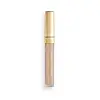theBalm Cosmetics Anne T. Dotes Concealer Versus Revolution Beauty Ultimate Radiant Under Eye Concealer
What's inside
What's inside
 Key Ingredients
Key Ingredients

 Benefits
Benefits

 Concerns
Concerns

 Ingredients Side-by-side
Ingredients Side-by-side

Cocos Nucifera Oil
MaskingRicinus Communis Seed Oil
MaskingSimmondsia Chinensis Seed Oil
EmollientCopernicia Cerifera Wax
Mica
Cosmetic ColorantC26-28 Alkyl Dimethicone
Skin ConditioningHelianthus Annuus Seed Oil
EmollientOryza Sativa Bran Extract
Skin ConditioningLauroyl Lysine
Skin ConditioningElaeis Guineensis Oil
EmollientBidens Pilosa Extract
HumectantGossypium Herbaceum Seed Oil
Skin ConditioningLinum Usitatissimum Seed Oil
PerfumingPhenoxyethanol
PreservativeHelianthus Annuus Extract
EmollientVitis Vinifera Seed Oil
EmollientCaprylyl Glycol
EmollientEthylhexylglycerin
Skin ConditioningHexylene Glycol
EmulsifyingRosmarinus Officinalis Leaf Extract
AntimicrobialTocopherol
AntioxidantCI 77891
Cosmetic ColorantIron Oxides
Cocos Nucifera Oil, Ricinus Communis Seed Oil, Simmondsia Chinensis Seed Oil, Copernicia Cerifera Wax, Mica, C26-28 Alkyl Dimethicone, Helianthus Annuus Seed Oil, Oryza Sativa Bran Extract, Lauroyl Lysine, Elaeis Guineensis Oil, Bidens Pilosa Extract, Gossypium Herbaceum Seed Oil, Linum Usitatissimum Seed Oil, Phenoxyethanol, Helianthus Annuus Extract, Vitis Vinifera Seed Oil, Caprylyl Glycol, Ethylhexylglycerin, Hexylene Glycol, Rosmarinus Officinalis Leaf Extract, Tocopherol, CI 77891, Iron Oxides
Water
Skin ConditioningDimethicone
EmollientPhenyl Trimethicone
Skin ConditioningIsododecane
EmollientHydrogenated Polycyclopentadiene
Talc
AbrasiveButylene Glycol
HumectantPolyglyceryl-4 Isostearate
EmulsifyingCetyl PEG/PPG-10/1 Dimethicone
EmulsifyingHexyl Laurate
EmollientHydrogenated Castor Oil
EmollientHydrogenated Microcrystalline Cera
Silica
AbrasivePhenoxyethanol
PreservativeMica
Cosmetic ColorantTriethoxycaprylylsilane
Aluminum Hydroxide
EmollientBenzoic Acid
MaskingNiacinamide
SmoothingDisodium EDTA
Dehydroacetic Acid
PreservativePropylene Glycol
HumectantTrimethoxycaprylylsilane
SmoothingEthylhexylglycerin
Skin ConditioningBHT
AntioxidantAscorbic Acid
AntioxidantTin Oxide
AbrasiveSodium Hyaluronate
HumectantAcacia Seyal Gum Extract
HumectantPotassium Sorbate
PreservativeIsopropyl Alcohol
SolventCI 77891
Cosmetic ColorantCI 77492
Cosmetic ColorantCI 77491
Cosmetic ColorantCI 77499
Cosmetic ColorantWater, Dimethicone, Phenyl Trimethicone, Isododecane, Hydrogenated Polycyclopentadiene, Talc, Butylene Glycol, Polyglyceryl-4 Isostearate, Cetyl PEG/PPG-10/1 Dimethicone, Hexyl Laurate, Hydrogenated Castor Oil, Hydrogenated Microcrystalline Cera, Silica, Phenoxyethanol, Mica, Triethoxycaprylylsilane, Aluminum Hydroxide, Benzoic Acid, Niacinamide, Disodium EDTA, Dehydroacetic Acid, Propylene Glycol, Trimethoxycaprylylsilane, Ethylhexylglycerin, BHT, Ascorbic Acid, Tin Oxide, Sodium Hyaluronate, Acacia Seyal Gum Extract, Potassium Sorbate, Isopropyl Alcohol, CI 77891, CI 77492, CI 77491, CI 77499
Ingredients Explained
These ingredients are found in both products.
Ingredients higher up in an ingredient list are typically present in a larger amount.
Ci 77891 is a white pigment from Titanium dioxide. It is naturally found in minerals such as rutile and ilmenite.
It's main function is to add a white color to cosmetics. It can also be mixed with other colors to create different shades.
Ci 77891 is commonly found in sunscreens due to its ability to block UV rays.
Learn more about CI 77891Ethylhexylglycerin (we can't pronounce this either) is commonly used as a preservative and skin softener. It is derived from glyceryl.
You might see Ethylhexylglycerin often paired with other preservatives such as phenoxyethanol. Ethylhexylglycerin has been found to increase the effectiveness of these other preservatives.
Mica is a naturally occurring mineral used to add shimmer and color in cosmetics. It can also help improve the texture of a product or give it an opaque, white/silver color.
Serecite is the name for very fine but ragged grains of mica.
This ingredient is often coated with metal oxides like titanium dioxide. Trace amounts of heavy metals may be found in mica, but these metals are not harmful in our personal products.
Mica has been used since prehistoric times throughout the world. Ancient Egyptian, Indian, Greek, Roman, Aztec, and Chinese civilizations have used mica.
Learn more about MicaPhenoxyethanol is a preservative that has germicide, antimicrobial, and aromatic properties. Studies show that phenoxyethanol can prevent microbial growth. By itself, it has a scent that is similar to that of a rose.
It's often used in formulations along with Caprylyl Glycol to preserve the shelf life of products.